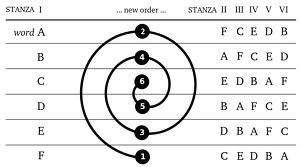But, I digress. You came here to learn about sestinas. Maybe the word rings a bell, taking you back to freshman English and that sonnet you had to memorize and recite in front of the class.
Oh, I see. You blocked that out, didn’t you? Well, never fear. A sestina is simply this:
1) A poem of 39 lines
2) with six stanzas, of six lines each
3) followed by an envoi of three lines.
4) The lines are unrhymed
5) and contain the same six end-words in each stanza
6) but in a changing order that follows a set pattern.
7) The envoi (last three lines) gathers up all six end words.
Okay, I can see your head spinning. Perhaps you’re a visual learner. Does this help?
When I see this chart, it reminds me of math, and I hate math. But there’s something quite nice about using a formula to write. Once you’ve committed to a form, once you’ve chosen your six words in the case of a sestina (as you can imagine, that choice is very important), you’re free to be as creative as you want to be, but with a safety net in place. Sometimes, having a billion choices available to you can stifle the creative process. Sometimes, limiting your options can actually lead to something wonderful and surprising.
I spend 95.356% of my writing time on prose, but occasionally a poem sneaks in, though almost always in free verse. This piece in McSweeneys is the first sestina I’ve attempted. Will it be my last? Not sure. But I do know that writing poetry exercises a different part of my writing brain, and considering I’ve been devoting nearly all my hours toward finishing a novel, that other part of my brain is looking a little flabby.
And so, next for me…Heroic Couplets!!! Mmmm, maybe not.

